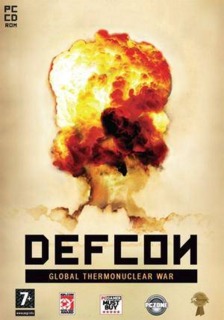A curious game. The only way to win is not to play.
The scenario is simple; it is the end of the world, and you must kill as many of your enemies’ citizens as possible whilst trying to defend yourself from them doing the same. Global Thermonuclear war is never as clear cut as there being winners and losers, but DEFCON plays on the principal that one side can lose less. You begin a round by selecting a region which has got The Bomb, North America, South America, Europe, Africa, The USSR or Asia. Gameplay is controlled through the different DEFCON conditions, with five being peace time and one being World War Three. Every game starts during DEFCON 5, where you will place airbases, missile silos, and satellites and deploy naval infantry such as aircraft carriers and nuclear submarines in tactical areas, both offensive and defensive. This carries on throughout DEFCON 4, and DEFCON 3 is where you can send fighter jets over enemy territory for reconnaissance, and possibly begin scrapping it out in the sea, and DEFCON 2 is more of the same. But with DEFCON 1 comes the time to break out the Jammy Dodgers, nail your furniture to the wall and cower under the stairs, as it’s time to nuke the hell out of everything
DEFCON is about detached as a game can get. There are no cut scenes, no voice over, and no music other than the sounds of the bunker you are sitting in; the hum of processed air, the distant sounds of a tannoy system giving orders to the bunker, garbled radio chatter, the weeping of a fellow government employee aware of what is happening outside, and the shrill interruption of a claxon, indicating the launch of a missile. It really makes the game feel more than just a computer simulation, and that you are actually dictating the final devastating actions of the modern world before it all ends with a blinding flash.
The presentation is equally uninvolved, reporting the details of megadeaths caused and received with complete indifference. Aside from the pop up text, the only other report of a nuclear hit is the white cloud left behind a minute or so after impact. It doesn’t elaborate on what has happened, leaving your mind to contemplate the destruction it signifies. The presentation is simple but undoubtedly sharp. The computer simulated world map shows the earth and key locations like cities with a cool, clinical blue interface. Coastlines outlined with jagged edges, and populated zones filled in with colours, the brighter the colour the greater the density. This is interrupted by the presence of enemies and allies missiles arcing their way across the sky. When every nation launches simultaneously, the screen becomes awash with neon confusion. When you zoom out for a moment and look at the arcs blazing across the sky, it all seems menacingly beautiful, even if it does mean your cities are about to become slightly less populated.
To mix things up a bit, there are various different game modes available. Office mode takes a minimum of 6 hours to play, and comes with the ability to quickly minimize the action, perfect for giving the impression that you are working rather than nuking the world. Speed DEFCON by contrast takes only 15 minutes to play. Here, carefully planned strategy is pretty much thrown out the window in exchange for frantic nuking action. Then there is Alliance mode, where every player begins on the same team, but after some backstabbing and a break down of communication the coalition will eventually crumble and everybody will kill each other. These can all be played with AI players, but they fail to offer the challenge and unique fun an online match can offer. For instance, you can attempt to kick someone from your alliance, but if too few people agree with that notion then the whole group will be aware of your traitorous intentions, and you will have to think fast to worm your way out of a nuclear retribution. Or you can stick with an alliance right the way through an entire match, only to completely turn on them and unleash that silo primed with nukes on your unsuspecting friends as the victory timer begins to tick. Of course, you will have to deal with one or two jerks, and sometimes the person hosting the server will close it down, exiting the whole game, but these are normal irritations that come with online games.
DEFCON is an immersive experience. The first couple of times I played it, I found it genuinely unsettling, and whilst that did give way after a while, it still remains one of the most memorable games I’ve played in a while. You can pick it up for a steal from Steam for about £10, which does reflect the lifespan; with only one map, there are only so many strategies before it starts getting repetitive. But at that bargain price, you really shouldn’t care. It’s a lot more interesting than a nice game of chess.

